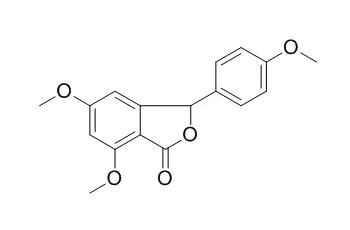METHODS AND RESULTS:
From the fruits and leaves of Aglaia erythrosperma (Meliaceae), 10 chemical constituents were isolated and identified, i.e. the dammarane triterpenoids cabraleadiol (1), cabraleahydroxylactone (2), ethyl eichlerianoate (3), eichlerialactone (4), aglinin A (5), cabralealactone (6), the aglaialactone 5,6-Desmethylenedioxy-5-methoxyaglalactone (7), the flavagline 4'-demethoxy-3',4'-methylenedioxy-methyl rocaglate (8) and two coumarins: scoparone and scopoletin.
CONCLUSIONS:
Flavagline 8 exhibited antimalarial activity with an IC(50) value of 7.30 μg mL(-1) and was strongly cytotoxic against small cell lung cancer (NCI-H187), epidermoid carcinoma (KB) and breast cancer (BC) cell lines, with IC(50) values of 2.17, 2.10 and 0.11 μg mL(-1), respectively. Aglinin A (5) displayed moderate cytotoxicity against all the three cancer cell lines, whereas ethyl eichlerianoate (3), cabralealactone (6) and the aglaialactone 7 were exclusively cytotoxic to NCI-H187 cell line. Cabraleahydroxylactone (2) showed antiviral activity against herpes simplex virus type-1 with an IC(50) value of 3.20 μg mL(-1), in comparison with the standard acyclovir (IC(50) = 1.90 μg mL(-1)). When tested for antimycobacterial activity against Mycobacterium tuberculosis H(37)Ra, compounds 1-4 and 6-8 displayed minimum inhibitory concentration in the range of 25-50 μg mL(-1). |






 Cell. 2018 Jan 11;172(1-2):249-261.e12. doi: 10.1016/j.cell.2017.12.019.IF=36.216(2019)
Cell. 2018 Jan 11;172(1-2):249-261.e12. doi: 10.1016/j.cell.2017.12.019.IF=36.216(2019) Cell Metab. 2020 Mar 3;31(3):534-548.e5. doi: 10.1016/j.cmet.2020.01.002.IF=22.415(2019)
Cell Metab. 2020 Mar 3;31(3):534-548.e5. doi: 10.1016/j.cmet.2020.01.002.IF=22.415(2019) Mol Cell. 2017 Nov 16;68(4):673-685.e6. doi: 10.1016/j.molcel.2017.10.022.IF=14.548(2019)
Mol Cell. 2017 Nov 16;68(4):673-685.e6. doi: 10.1016/j.molcel.2017.10.022.IF=14.548(2019)